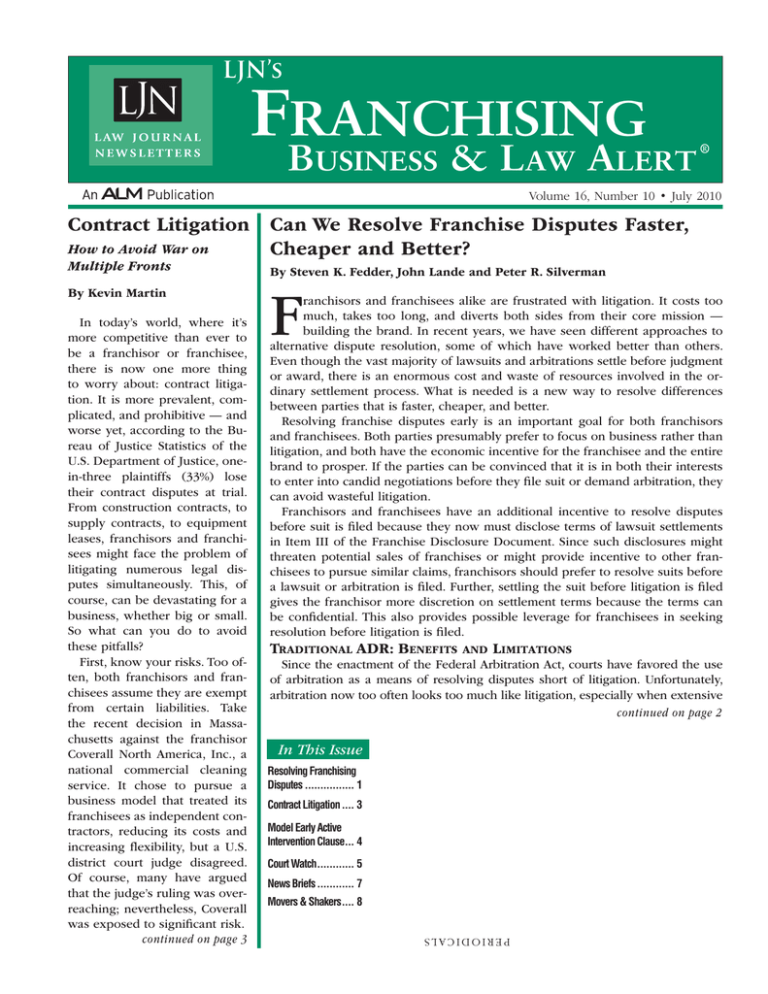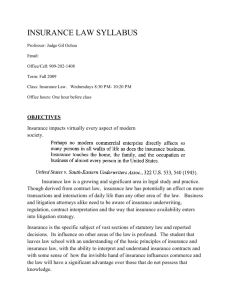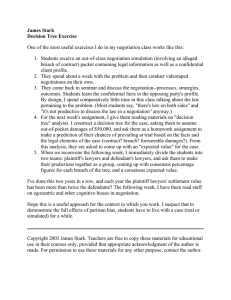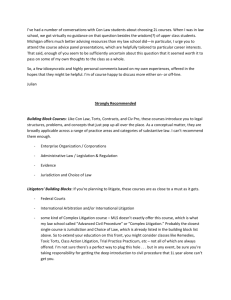F
advertisement

LJN’s Franchising Business & Law Alert ® Volume 16, Number 10 • July 2010 How to Avoid War on Multiple Fronts By Kevin Martin In today’s world, where it’s more competitive than ever to be a franchisor or franchisee, there is now one more thing to worry about: contract litigation. It is more prevalent, complicated, and prohibitive — and worse yet, according to the Bureau of Justice Statistics of the U.S. Department of Justice, onein-three plaintiffs (33%) lose their contract disputes at trial. From construction contracts, to supply contracts, to equipment leases, franchisors and franchisees might face the problem of litigating numerous legal disputes simultaneously. This, of course, can be devastating for a business, whether big or small. So what can you do to avoid these pitfalls? First, know your risks. Too often, both franchisors and franchisees assume they are exempt from certain liabilities. Take the recent decision in Massachusetts against the franchisor Coverall North America, Inc., a national commercial cleaning service. It chose to pursue a business model that treated its franchisees as independent contractors, reducing its costs and increasing flexibility, but a U.S. district court judge disagreed. Of course, many have argued that the judge’s ruling was overreaching; nevertheless, Coverall was exposed to significant risk. continued on page 3 Can We Resolve Franchise Disputes Faster, Cheaper and Better? By Steven K. Fedder, John Lande and Peter R. Silverman F ranchisors and franchisees alike are frustrated with litigation. It costs too much, takes too long, and diverts both sides from their core mission — building the brand. In recent years, we have seen different approaches to alternative dispute resolution, some of which have worked better than others. Even though the vast majority of lawsuits and arbitrations settle before judgment or award, there is an enormous cost and waste of resources involved in the ordinary settlement process. What is needed is a new way to resolve differences between parties that is faster, cheaper, and better. Resolving franchise disputes early is an important goal for both franchisors and franchisees. Both parties presumably prefer to focus on business rather than litigation, and both have the economic incentive for the franchisee and the entire brand to prosper. If the parties can be convinced that it is in both their interests to enter into candid negotiations before they file suit or demand arbitration, they can avoid wasteful litigation. Franchisors and franchisees have an additional incentive to resolve disputes before suit is filed because they now must disclose terms of lawsuit settlements in Item III of the Franchise Disclosure Document. Since such disclosures might threaten potential sales of franchises or might provide incentive to other franchisees to pursue similar claims, franchisors should prefer to resolve suits before a lawsuit or arbitration is filed. Further, settling the suit before litigation is filed gives the franchisor more discretion on settlement terms because the terms can be confidential. This also provides possible leverage for franchisees in seeking resolution before litigation is filed. Traditional ADR: Benefits and Limitations Since the enactment of the Federal Arbitration Act, courts have favored the use of arbitration as a means of resolving disputes short of litigation. Unfortunately, arbitration now too often looks too much like litigation, especially when extensive continued on page 2 In This Issue Resolving Franchising Disputes................. 1 Contract Litigation..... 3 Model Early Active Intervention Clause.... 4 Court Watch............. 5 News Briefs............. 7 Movers & Shakers..... 8 PERIODICALS Contract Litigation Resolve Disputes continued from page 1 A New Direction discovery occurs. Also, numerous franchisors and other businesses have experienced protracted battles in court or the arbitration over the scope and fairness of arbitration clauses, whether limitations on class actions are enforceable, who can award attorneys’ fees, and the availability and scope of judicial review. Many franchise agreements now provide for mandatory pre-suit mediation, but there is no consensus on whether mandatory mediation clauses should be used in franchise agreements. Franchisors and franchisees who want to settle and who have good lawyers will know when a dispute is ripe for resolution, and mediation can be very successful if both parties proceed in good faith. But if those factors are not present, mandatory mediation can be a waste of time and money. Also, once suit is filed, parties often choose to mediate, or courts will order it. But this frequently occurs only after parties have spent a lot of time and money and have learned little more than they knew at the suit’s inception. Recognizing the inherent weaknesses in traditional ADR, scholars and lawyers are developing new techniques to refine and improve the process. A number of different approaches have been evolving over the years, which we identify Steven K. Fedder is a partner at Leitess Leitess Friedberg + Fedder P.C. in Baltimore. He can be contacted at steven.fedder@llff.com. John Lande is the Isidor Loeb Professor and Director of the LLM Program in Dispute Resolution at the University of Missouri School of Law and has written extensively about cooperative and collaborative processes. His Web site is www.law.missouri. edu/lande/. Peter R. Silverman is a partner in the litigation practice group in the Toledo, OH, office of Shumaker, Loop & Kendrick, LLP. He can be contacted at psilverman@ slk-law.com. 2 collectively as “Planned Early Negotiation.” Lawyers have developed several processes addressing the problems of unplanned negotiation that occur late in a lawsuit. These “planned early negotiation” processes — “collaborative practice,” “cooperative practice,” and “settlement counsel” — encourage lawyers and parties to focus on negotiation early in a matter, preferably before a party has filed suit. These are voluntary processes that require the parties to get serious about negotiation from the outset. The lawyers for each party begin by assessing whether the matter is appropriate for early negotiation and discussing this with their clients. If the clients want to use one of the processes, the lawyers work together to plan the procedure. The processes generally involve one or more face-to-face negotiation sessions with the parties in the dispute, as well as with their lawyers. One of the most important parts of the procedure is having a plan for the exchange of information so that both sides can reasonably evaluate their respective positions. Instead of bombarding each other with burdensome, overbroad discovery requests, the lawyers agree to promptly and voluntarily exchange the critical information. Only rarely do these exchanges uncover a “smoking gun” document that one side wants to hide; the documents are generally a small subset of documents that would otherwise have to be produced in the course of discovery. After the parties have exchanged information, they use interest-based negotiation (“IBN”) to develop a solution that works for both sides. This involves discussion of each side’s interests and creative problem-solving to look for positive-sum solutions where both parties satisfy important interests. IBN allows the parties to consider issues such as confidentiality and business reputation, establishment of new procedures, and prevention of ancillary harm (such continued on page 3 Franchising Business & Law Alert ® EDITOR-IN-CHIEF . . . . . . . . . . . . . Erik B. Wulff DLA Piper Washington, DC EDITORIAL DIRECTOR . . . . . . . . . Wendy Kaplan Stavinoha ASSOCIATE EDITOR . . . . . . . . . . . Kevin Adler SENIOR MANAGING EDITOR . . . . Julie Gromer MARKETING DIRECTOR . . . . . . . . Jeannine Kennedy GRAPHIC DESIGNER . . . . . . . . . . Louis F. Bartella BOARD OF EDITORS MARK ABELL . . . . . . . . . . . . . . . JOHN R. F. BAER . . . . . . . . . . . . . RUPERT M. BARKOFF . . . . . . . . JOEL R. BUCKBERG . . . . . . . . . KENNETH R. COSTELLO . . . . . . JENNIFER DOLMAN . . . . . . . . . GARY R. DUVALL . . . . . . . . . . . . PETER C. LAGARIAS . . . . . . . . . BRET LOWELL . . . . . . . . . . . . . . CHARLES G. MILLER CHARLES S. MODELL . . . . . . . . ARTHUR L. PRESSMAN . . . . . . . ROBERT L. PURVIN, JR. . . . . . . CHARLES RUMBAUGH. . . . . . . . MICHAEL H. SEID . . . . . . . . . . . ANDREW C. SELDEN . . . . . . . . MATTHEW R. SHAY . . . . . . . . . . ALAN H. SILBERMAN . . . . . . . . ROCHELLE B. SPANDORF . . . . . HOWARD S. WOLFSON . . . . . . Field Fisher Waterhouse London Greensfelder, Hemker & Gale, P.C. Chicago Kilpatrick Stockton, LLP Atlanta Baker, Donelson, Bearman , Caldwell & Berkowitz, P.C. Nashville Bryan Cave LLP Santa Monica, CA Osler, Hoskin & Harcourt LLP Toronto, Ontario Dorsey & Whitney, LLP Seattle The Legal Solutions Group, L.L.P. San Rafael, CA DLA Piper Washington, DC Bartko, Zankel, Tarrant & Miller, PC San Francisco Larkin, Hoffman, Daly & Lindgren, Ltd. Bloomington, MN Nixon Peabody Boston American Association of Franchisees & Dealers San Diego Private Dispute Resolution Rolling Hills, CA Michael H. Seid & Associates, LLC West Hartford, CT Briggs and Morgan Minneapolis International Franchise Association Washington, DC Sonnenschein Nath & Rosenthal Chicago Davis, Wright & Tremaine, LLP Los Angeles Morrison Cohen Singer & Weinstein, LLP New York LJN’S Franchising Business & Law Alert® (ISSN 1079-6339) is published by Law Journal Newsletters, a division of ALM. © 2010 ALM Media, LLC. All rights reserved. No reproduction of any portion of this issue is allowed without written permission from the publisher. Telephone: (877) 256-2472 Editorial e-mail: jgromer@alm.com Circulation e-mail: customercare@alm.com Reprints: www.almreprints.com LJN’s Franchising Business & Law Alert 023145 Periodicals Postage Paid at Philadelphia, PA POSTMASTER: Send address changes to: ALM 120 Broadway, New York, NY 10271 Published Monthly by: Law Journal Newsletters 1617 JFK Boulevard, Suite 1750, Philadelphia, Pa 19103 www.ljnonline.com LJN’s Franchising Business & Law Alert ❖ www.ljnonline.com/alm?franchising July 2010 Resolve Disputes continued from page 2 as loss of credit rating or business opportunities). Early settlement itself is a positive-sum solution, given that it saves litigation costs, eliminates uncertainty, and allows parties to return to focusing solely on business. This contrasts with zero-sum negotiation at the end of litigation where each party’s gain is the other party’s loss — and both sides incur large legal bills. IBN lends itself well to franchise cases because in many disputes, the franchisee continues to do business with the franchisor; therefore, early interest-based resolution of the dispute should serve as a platform for a better relationship. Even in termination cases, the parties have an ongoing relationship because terminated franchisees often voice their anger publicly, and they are listed in the FDD. An interest-based resolution can lessen the animosity stemming from ending the franchise relationship. The parties may use mediators, experts, neutral evaluators, or other professionals to assist in the negotiation. Collaborative practice is now used almost exclusively in family law cases, but it can be effectively applied to business disputes. In collaborative practice, both parties hire lawyers who have limited the scope Avoid War continued from page 1 Beyond employment and compensation issues, another common area of poor risk management is arbitration clauses. While found in many contracts, such clauses do not guarantee you won’t end up court. Kevin Martin is the founder and chief executive officer of Sonoma Risk Insurance Agency (www.sonomarisk. com), a litigation insurance company based in Los Angeles. He is a former partner of Bingham McCutchen LLP and was senior counsel with the Securities and Exchange Commission Division of Enforcement. July 2010 of their representation in the matter to negotiation. The parties and the lawyers sign a “participation agreement,” which provides that the parties and lawyers focus solely on using IBN to resolve the issues. The participation agreement includes a “disqualification” provision stating that if either party wants to use contested litigation, both lawyers are disqualified from representing the parties in litigation. If the parties want representation in litigation, they must hire new litigation counsel. This disqualification provision creates an incentive for everyone to work hard to settle the matter. A variation on this process is referred to as “cooperative law.” The key difference is that, while the parties initially pursue settlement using the same cooperative negotiation principles, the lawyers are not disqualified from litigating. This may be more efficient, though the parties and lawyers might not be as committed to resolution through negotiation. “Settlement counsel” is a related process that is more commonly used in business disputes. Any party may hire a lawyer solely for negotiation, regardless of whether the other side also hires settlement counsel. When parties engage settlement counsel, they may or may not also simultaneously engage litigation counsel. If so, this could be handled in a number of different ways. Inside counsel could serve as settlement counsel, and outside counsel could serve as litigation counsel. Or one lawyer in a firm could serve as settlement counsel, and another lawyer at the firm could serve as litigation counsel. Or settlement and litigation counsel could be from different firms. Compensation can come into play if, for example, the client offers incentives to settlement counsel for resolving the dispute early. For example, the Ninth Circuit in Nagrampa v. Mailcoups Inc., 469 F.3d 1257 (2006), found that an arbitration between a franchisor and a franchisee was both procedurally and substantively uncontainable. Regardless of the validity of the Coverall ruling or the specifics of an individual arbitration clause, the point remains the same: The better you understand your risk exposure as a franchisor or franchisee, the less likely you are to end up with liability. Another development altering the risk landscape for franchisors and franchisees is the growth of predominately “loser pays” jurisdictions and the spread of “loser pays” or prevailing party provisions. (Loser pays provisions are, of course, borne out of the English model, where the plaintiff is required to pay the adversary’s legal fees in the case of an adverse ruling.) Numerous mini “loser pays” systems are emerging in the United States, such as in Oregon and Alaska. As a result, a franchisor with a regional footprint needs to be aware of the full extent of its liabilities if it sues a franchisee and loses. Similarly, franchisees should take the existence of “loser pays” systems into account when deciding to do business. Regrettably, both the legal and business communities have been paying little continued on page 8 Early Active Intervention Co-author Peter Silverman has developed a process that he calls Early Active Intervention (“EAI”) to tailor a cooperative process to franchise disputes. EAI involves a voluntary effort on both sides to resolve the dispute as early, quickly, and inexpensively as possible. The parties can use a facilitator, who can structure a limited information exchange if a case is not ripe for resolution, which many mediators don’t do. Then the facilitator helps parties and lawyers work out an agreement. See model EAI clause for franchise agreements on page 4. Conclusion Franchisors and franchisees need faster, cheaper, and better ways to resolve disputes. Planned early negotiation processes and early active intervention clauses can help parties and lawyers achieve these goals. —❖— LJN’s Franchising Business & Law Alert ❖ www.ljnonline.com/alm?franchising 3 Model Early Active Intervention Clause for Franchise Agreements Early active intervention. If either of us has a claim against the other that we have not been able to resolve through unstructured negotiation, either of us may invoke early active intervention (“EAI”) to commence structured negotiation before filing [suit or arbitration]. EAI is subject to the following rules: 1. Initiation of the process. You or we initiate EAI by sending notice (the “Notice”) to the other party that states that the initiating party is initiating EAI, and that provides a concise statement of the claim. 2. Tolling. Initiation of EAI tolls the statute of limitations on the initiating party’s claims. The other party may terminate tolling on 14 days’ notice. 3. Response. Within 7 days of receiving the Notice, the other party shall send the initiating party a statement whether the other party will participate in EAI and, if so, a concise substantive response (the “Response”) to the initiating party’s claim. 4. Direct negotiation. You and we may (but are not required to) begin direct negotiations within 3 days of the receipt of the Response. We shall use effective negotiation principles as follows: i. Parties with authority. We will each arrange for attendance at the negotiation of the people on our respective sides who have the authority to resolve the dispute. ii. Goal and principles. The goal of negotiation will be to seek a business resolution of the dispute through cooperative communication. We shall focus on each other’s most important interests, seek to generate options to satisfy those interests, and consider possible objective standards to evaluate interests and options. iii. Need for further information or documents. If the dispute is not resolved at our initial negotiation session, we shall determine whether either party needs further information or documents to reasonably evaluate the issues. If either side needs such information or documents, we shall set a time period for exchange of information and documents. Normally, this period will be no more than 30 days after the date of our agreement. iv. Further negotiation. If we agree to continue negotiation following information and document exchange, negotiation shall begin within 14 days after completion of the exchange. 5. Selection of EAI facilitator. i. Timing. At any time, if we believe that a neutral facilitator would assist us in negotiation, we shall mutually and promptly select an EAI facilitator. ii. Fees. We will each be responsible for half of the facilitator’s fees. 6. Case facilitation process. Within seven days of the facilitator’s selection, the facilitator shall hold a case facilitation conference by telephone. The conference shall address the following topics: i. Information and document exchange. If we have not agreed on exchange of information or documents, the facilitator may decide on the appropriate scope of information and document exchange. The presumption shall be to require only that discovery necessary to give the parties enough information to reasonably evaluate the merits of our respective positions. The facilitator shall set a short time limit to finish exchange of information and documents. Normally, this exchange will be completed no later than 30 days after the telephone case facilitation conference. ii. Facilitation schedule and site. The facilitator shall set a date for a face-to-face case facilitation conference. The conference shall be scheduled no later than 30 days after the end of information and document exchange. The facilitator shall decide the place of the conference after consulting with us. iii. Facilitation conference. The facilitator may require us to submit materials to the facilitator that we send confidentially to only the facilitator and/or that we share with each other. We will each arrange for the attendance at the conference of the people on our respective sides who have the authority to resolve the dispute. The facilitator’s role will be to actively mediate the dispute with the goal of seeking resolution. iv. Litigation management. If we are unable to resolve the dispute at the conference, the facilitator shall assist us in developing a litigation management agreement to cover discovery, time limits, and other matters to seek to limit the cost and time of [suit or arbitration]. v. Flexibility. The facilitator shall have the discretion to alter these rules as the facilitator sees fit. 7. Method of written communication. All written communication shall be by e-mail. For purposes of calculating dates, receipt of written communications will be deemed contemporaneous with sending. 8. Modification of the process. If the facilitator believes that modifying the procedure is appropriate, the facilitator may do so after consulting with the parties. 9. Voluntary termination. Either party may terminate the EAI process at any time by sending three days’ notice to the other. Source: Peter R. Silverman (psilverman@slk-law.com) —❖— 4 LJN’s Franchising Business & Law Alert ❖ www.ljnonline.com/alm?franchising July 2010





